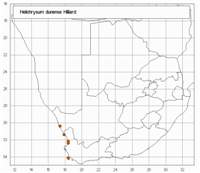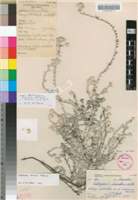Origin of name:
dunense = from the dunes
Diagnostic characters:
Small round grey leaves widely spaced on branchesSmall heads in small terminal clustersBracts tinged pink in center
Description:
Perennial herb, taproot woody, stems many from the crown, up to 600 mm long, loosely branched, more or less prostrate, thinly white or greyish-white woolly, closely leafy. Leaves mostly 6-10 x 2.5-4.5 mm, spathulate, apex rounded, base broad, half-clasping, both surfaces closely greyish-white woolly. Heads homogamous, cylindric-campanulate, c. 4-5 x 3 mm, several clustered at the branch tips closely surrounded by leaves. Involucral bracts in 4 series, soon caducous, outer short, webbed with wool to surrounding leaves, others subequal, about equaling the flowers, not radiating, translucent, often tinged purple, tips abruptly acute, opaque, light golden-brown. Receptacle nearly smooth. Flowers c. 9-12. Achenes 0.75 mm long, glabrous. Pappus bristles many, about equaling the corolla, scabrid, bases with obsolete patent cilia.
Flowering between October and December.
Distribution:
On sand dunes. Known from a few collections on the Western and Northern Cape coast in the vicinity of Lambert's Bay and at Hondeklipbaai and Grootderm in Namaqualand.
Fynbos and Succulent Karoo Biomes.
Notes:
Not unlike H. litorale in facies, but more loosely branched and pappus uniseriate.
Taxonomy:
Literature:
Helichrysum dunense Hilliard in Flora of southern Africa 33,7 (2): 143 (1983).
Type:
Western Cape, Clanwilliam div., 1 mile S. of Steenbokfontein (S. of Lambert's Bay), coastal sand dunes, 11 xii 1963, Nordenstam 3412 (E, holo.; S, iso.).
Synonym(s):
Vouchers:
Acocks 19898 (PRE); Boucher 2603 (STE); Pillans 18066 (BOL).


